The Warm Hospitality of the Snow Country
Japan’s regions are rich in unique seasonal expressions. In the snow country, this very oment people are braving the snow and living together with the snow. The city of Minamiuonuma in Niigata Prefecture is one of the snowiest districts in Japan. Although it is only about two hours away from Tokyo by train, the snowy scenery all around gives visitors the feeling that they have arrived in an unknown world. In this issue, IHCSA Café introduces the hospitality and wintry elegance of two hot-spring ryokan in this district: Irorian, which is located in the town of Muika-machi in Minamiuonuma and is surrounded by mountain valley nature, and Ryugon, which has superb buildings reconstructed from the residences of village headmen and wealthy farmers in Echigo (present-day Niigata Prefecture).
Buried snugly in snow: Irorian
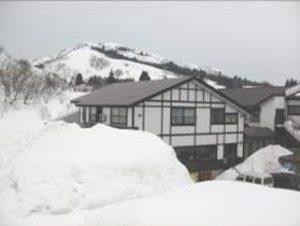
Enjoy the snow as you please
The snow in this region usually lies more than two meters deep and creates a silvery white world spreading out in all directions. Piling up much higher than the human body, the heavy snow mercilessly puts pressure on both people and things. Nevertheless, the experience of being enveloped by snow is magical. Especially on a night with a full moon in a cloudless sky, the sight of sparkling blue moonlight reflected off the snow is simply indescribable. And although the winter in this region is certainly harsh, the severity is relatively mild. There are actually very few blizzards; the snow seems to wrap around you like fluffy down. It is, therefore, a good region for people living in big cities and not so accustomed to snow to visit. The hot-spring ryokan Irorian at Uenohara Kogen Onsen is buried snugly in snow as well. People who come here for the snow use Irorian as a base from where to go out and enjoy the snow to their heart’s content, walking around fields of untrodden new snow or strolling through snowy forests following the footprints of animals. Guests are recommended to wear the traditional snowshoes rented out by the ryokan to prevent their feet from sinking into the snow. The paddy field behind the ryokan has been developed as a kid’s playground especially for family guests. Both children and their parents completely forget about the passage of time as they have fun in the snow, joyfully riding on sledges or building snowmen. Some people put on hooded straw raincoats and become snow fairies. There is also a kamakura (snow hut) with room for about 10 people. You can enjoy a very memorable time in the late afternoon here, enjoying the toasted rice cakes and shiruko porridge that are served in this hut. The snow lanterns in front of the ryokan‘s entrance greet guests arriving after dark with an air of fantasy.
The hot-spring ryokan Irorian at Uenohara Kogen Onsen is buried snugly in snow as well. People who come here for the snow use Irorian as a base from where to go out and enjoy the snow to their heart’s content, walking around fields of untrodden new snow or strolling through snowy forests following the footprints of animals. Guests are recommended to wear the traditional snowshoes rented out by the ryokan to prevent their feet from sinking into the snow. The paddy field behind the ryokan has been developed as a kid’s playground especially for family guests. Both children and their parents completely forget about the passage of time as they have fun in the snow, joyfully riding on sledges or building snowmen. Some people put on hooded straw raincoats and become snow fairies. There is also a kamakura (snow hut) with room for about 10 people. You can enjoy a very memorable time in the late afternoon here, enjoying the toasted rice cakes and shiruko porridge that are served in this hut. The snow lanterns in front of the ryokan‘s entrance greet guests arriving after dark with an air of fantasy.


A leisurely, peaceful break
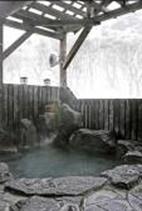 After all that fun in the snow, the hot-spring baths are just what you need to soothe your exhausted body. At Irorian, there is an outdoor bath where you can gaze at the snowy scenery while soaking in the natural hot-spring water. There is also a herbal bath that is said to have various medicinal benefits.
After all that fun in the snow, the hot-spring baths are just what you need to soothe your exhausted body. At Irorian, there is an outdoor bath where you can gaze at the snowy scenery while soaking in the natural hot-spring water. There is also a herbal bath that is said to have various medicinal benefits.
 Inside the ryokan, the atmosphere is countrified and composed, and the antique folk crafts displayed here and there add to the charm. Guests can take their delicious meals seated around an irori (sunken hearth), from which the ryokan takes its name. The menu consists of seasonal dishes with mainly local ingredients plus seafood caught in the Sea of Japan. Choice sake from the ricegrowing Echigo region goes down very well with the cuisine.
Inside the ryokan, the atmosphere is countrified and composed, and the antique folk crafts displayed here and there add to the charm. Guests can take their delicious meals seated around an irori (sunken hearth), from which the ryokan takes its name. The menu consists of seasonal dishes with mainly local ingredients plus seafood caught in the Sea of Japan. Choice sake from the ricegrowing Echigo region goes down very well with the cuisine.
The annex, a dismantled and reconstructed old cottage, is used as a tea ceremony room. After your meal, you can spend a pleasant evening here enveloped in a historical atmosphere, listening to the proprietress talk about local folk tales, traditions, and the lifestyles of people in the past.
Repeaters come to enjoy the four seasons
Irorian offers various seasonal plans to enable guests to fully enjoy their stay whenever they come. “They have chosen to come to this locality,” says the ryokan, “so we want them to get the most out of their stay.” Throughout the year guests are able to experience making cloth sandals and soba noodles using local buckwheat flour. At the adjacent Soan soba restaurant, the newly made soba with tempura of fresh mountain vegetables is truly superb. From mid-June until late August there is the fantastic spectacle of dancing fireflies. And autumn brings the satisfying taste of ricepot cooked new Minamiuonuma Koshihikari rice, said to be the best in Japan, and freshly harvested natural mushrooms.
Irorian also emphasizes supplying guests with local information that is most appropriate for them. The proprietress and staff endeavor to provide warmhearted hospitality in a casual manner.


Irorian
Uenohara Kogen Onsen, 2089-4 Koguriyama, Minamiuonuma, Niigata Prefecture 949-6636
Tel: 025-773-5847 Fax: 025-773-3110
URL: http://www.irorian.co.jp (Japanese only; English page under construction)
Access
By train: Take the JR Joetsu Shinkansen to Echigo-Yuzawa Station or Urasa Station;
change there to the Joetsu Line and get off at Muika-machi Station;
10 min. from there by car; pickup service available
By car: 10 min. from the Muika-machi Interchange on the Kanetsu Expressway
Majestic and tranquil: Ryugon
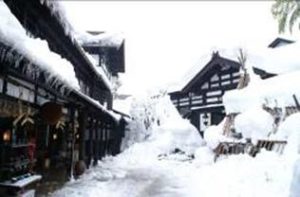 Saturated in an atmosphere of history
Saturated in an atmosphere of history
Ryugon, which takes its name from a temple that existed on this site in the past, makes visitors recall what Japan must have been like two centuries ago. The main building consists of former mansions belonging to village headmen and wealthy farmers that were relocated to this site; they were built 150-250 years ago and have withstood severe snowfalls ever since then. It is a wonderful example of a traditional Japanese architectural style; in particular, the stout beams and pillars are characteristic of the snow country. “Coming home”–Ryugon kindles the nostalgia that lies somewhere deep in the subconscious of the Japanese.
 After passing through the imposing black gate, guests are first of all shown to one of the drawing rooms (Otsuki no Ma) to rest their limbs after a tiring journey. These rooms were actually used as a living room and studies in the mansion of generations of village headmen in the later Edo period (1603-1868). The old timber gives a sense of solidity and warmth, and the sunken hearth and antique furnishings are restful on the eyes. Imitating the layout of mansions in the past, the long black-luster corridor stretches in a complicated fashion. As you head for the guest rooms, your attention will be frequently caught by the exquisite ornaments displayed along both sides and the plants outside the windows. Strolling around the large green garden, with its tea room annex, fountain, and waterfall, you will suddenly notice that you have forgotten all about the present world and are feeling quite relaxed both physically and mentally.
After passing through the imposing black gate, guests are first of all shown to one of the drawing rooms (Otsuki no Ma) to rest their limbs after a tiring journey. These rooms were actually used as a living room and studies in the mansion of generations of village headmen in the later Edo period (1603-1868). The old timber gives a sense of solidity and warmth, and the sunken hearth and antique furnishings are restful on the eyes. Imitating the layout of mansions in the past, the long black-luster corridor stretches in a complicated fashion. As you head for the guest rooms, your attention will be frequently caught by the exquisite ornaments displayed along both sides and the plants outside the windows. Strolling around the large green garden, with its tea room annex, fountain, and waterfall, you will suddenly notice that you have forgotten all about the present world and are feeling quite relaxed both physically and mentally.
 Unsparing and warmhearted service
Unsparing and warmhearted service
The ryokan grounds cover nearly 53,000 sq. meters, larger than Tokyo Dome, and there are 36 purely Japanese-style guest rooms with varying room plans and carefully arranged to offer pleasant views from their windows. Each room was named by head priests of Eiheiji, a head temple of the Soto Zen sect of Buddhism, and Untoan, known as the foremost temple in Echigo. In winter every room is equipped with a kotatsu (a lowtable used as a foot warmer), and charcoal fires are lit in rooms with irori (sunken hearths). So however cold it might be outside, guests can keep themselves warm.
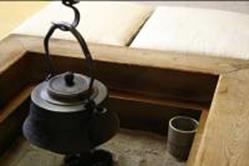 There are eight baths, including an outdoor bath from which the snow falls within reach, and guests can enjoy the atmosphere while warming themselves to the core. The sweet sake drinks that are served free of charge, made by local “grandmas” using methods inherited from the past, are a special treat in this region of harsh winters. And every evening from autumn until spring Ryugon holds rice-cake pounding meetings using mallets and mortars. Guests can enjoy the taste of freshly made rice cakes that have the extremely fine texture and stickiness unique to this region.
There are eight baths, including an outdoor bath from which the snow falls within reach, and guests can enjoy the atmosphere while warming themselves to the core. The sweet sake drinks that are served free of charge, made by local “grandmas” using methods inherited from the past, are a special treat in this region of harsh winters. And every evening from autumn until spring Ryugon holds rice-cake pounding meetings using mallets and mortars. Guests can enjoy the taste of freshly made rice cakes that have the extremely fine texture and stickiness unique to this region.
 In addition to the local cuisine and seafood from the Sea of Japan prepared by the cooks, every morning and evening the staff members take turns to toss firewood into the cooking stove and prepare rice according to the meal schedules of the guests. The Ryugon staff spare no effort to ensure that guests enjoy freshly cooked local Koshihikari rice with their meals. The kenchinjiru (vegetable soup) and pickles are simple, but they fully bring out the taste of the fresh food materials of this region, which is blessed in terms of its climate, clean water, and soil. They are carefully prepared and homely gems that only the “grandmas” born and brought up in this area know how to make. Furthermore, another popular attraction at Ryugon is the sight of freshly caught seasonal river fish being grilled vertically over a charcoal fire.
In addition to the local cuisine and seafood from the Sea of Japan prepared by the cooks, every morning and evening the staff members take turns to toss firewood into the cooking stove and prepare rice according to the meal schedules of the guests. The Ryugon staff spare no effort to ensure that guests enjoy freshly cooked local Koshihikari rice with their meals. The kenchinjiru (vegetable soup) and pickles are simple, but they fully bring out the taste of the fresh food materials of this region, which is blessed in terms of its climate, clean water, and soil. They are carefully prepared and homely gems that only the “grandmas” born and brought up in this area know how to make. Furthermore, another popular attraction at Ryugon is the sight of freshly caught seasonal river fish being grilled vertically over a charcoal fire.


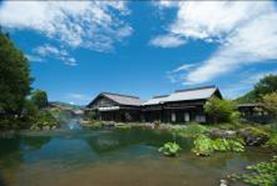 Affection for an irreplaceable region
Affection for an irreplaceable region
Whether rice-cake pounding or rice cooking, Ryugon makes no concessions in terms of giving guests the real thing according to how it was done in the region in the past. Guests can see, touch, and admire the Echigo traditions displayed everywhere in the facility, and they can listen to folk tales read in the local dialect. Services are provided in a way that stimulates the five senses of visitors. At the root lie the united, earnest, and unceasing efforts of staff members to convey their own sincere affection for the locality.
Ryugon
79 Sakado, Minamiuonuma, Niigata Prefecture 949-6611
Tel.: 025-772-3470 Fax: 025-772-2124
URL: http://www.ryugon.co.jp/ryugon (English)
Access
By train: Take the JR Joetsu Shinkansen to Echigo-Yuzawa Station or Urasa Station;
change there to the Joetsu Line and get off at Muika-machi Station;
5 min. from there by car; pickup service available
By car: 10 min. from the Muika-machi Interchange on the Kanetsu Expressway
Photos:
Courtesy of the ryokan and the Commerce and Industry-Tourism Department, Minamiuonuma-City
